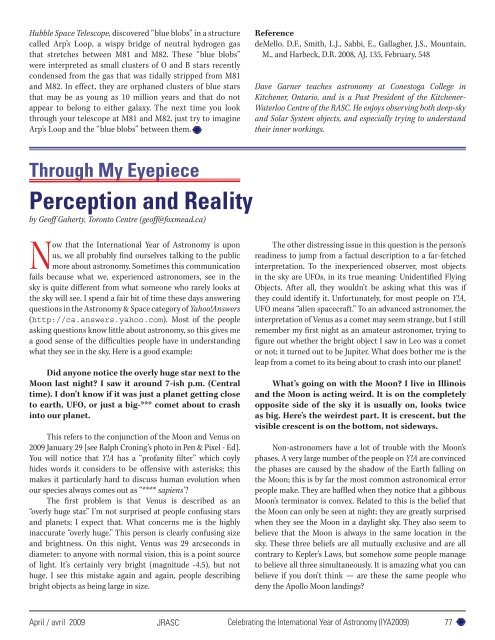Moment
insidethisissue - The Royal Astronomical Society of Canada
insidethisissue - The Royal Astronomical Society of Canada
Create successful ePaper yourself
Turn your PDF publications into a flip-book with our unique Google optimized e-Paper software.
Hubble Space Telescope, discovered “blue blobs” in a structurecalled Arp’s Loop, a wispy bridge of neutral hydrogen gasthat stretches between M81 and M82. These “blue blobs”were interpreted as small clusters of O and B stars recentlycondensed from the gas that was tidally stripped from M81and M82. In effect, they are orphaned clusters of blue starsthat may be as young as 10 million years and that do notappear to belong to either galaxy. The next time you lookthrough your telescope at M81 and M82, just try to imagineArp’s Loop and the “blue blobs” between them.ReferencedeMello, D.F., Smith, L.J., Sabbi, E., Gallagher, J.S., Mountain,M., and Harbeck, D.R. 2008, AJ, 135, February, 548Dave Garner teaches astronomy at Conestoga College inKitchener, Ontario, and is a Past President of the Kitchener-Waterloo Centre of the RASC. He enjoys observing both deep-skyand Solar System objects, and especially trying to understandtheir inner workings.Through My EyepiecePerception and Realityby Geoff Gaherty, Toronto Centre (geoff@foxmead.ca)Now that the International Year of Astronomy is uponus, we all probably find ourselves talking to the publicmore about astronomy. Sometimes this communicationfails because what we, experienced astronomers, see in thesky is quite different from what someone who rarely looks atthe sky will see. I spend a fair bit of time these days answeringquestions in the Astronomy & Space category of Yahoo!Answers(http://ca.answers.yahoo.com). Most of the peopleasking questions know little about astronomy, so this gives mea good sense of the difficulties people have in understandingwhat they see in the sky. Here is a good example:Did anyone notice the overly huge star next to theMoon last night? I saw it around 7-ish p.m. (Centraltime). I don’t know if it was just a planet getting closeto earth, UFO, or just a big-*** comet about to crashinto our planet.This refers to the conjunction of the Moon and Venus on2009 January 29 [see Ralph Croning’s photo in Pen & Pixel - Ed].You will notice that Y!A has a “profanity filter” which coylyhides words it considers to be offensive with asterisks; thismakes it particularly hard to discuss human evolution whenour species always comes out as “**** sapiens”!The first problem is that Venus is described as an“overly huge star.” I’m not surprised at people confusing starsand planets; I expect that. What concerns me is the highlyinaccurate “overly huge.” This person is clearly confusing sizeand brightness. On this night, Venus was 29 arcseconds indiameter: to anyone with normal vision, this is a point sourceof light. It’s certainly very bright (magnitude -4.5), but nothuge. I see this mistake again and again, people describingbright objects as being large in size.The other distressing issue in this question is the person’sreadiness to jump from a factual description to a far-fetchedinterpretation. To the inexperienced observer, most objectsin the sky are UFOs, in its true meaning: Unidentified FlyingObjects. After all, they wouldn’t be asking what this was ifthey could identify it. Unfortunately, for most people on Y!A,UFO means “alien spacecraft.” To an advanced astronomer, theinterpretation of Venus as a comet may seem strange, but I stillremember my first night as an amateur astronomer, trying tofigure out whether the bright object I saw in Leo was a cometor not; it turned out to be Jupiter. What does bother me is theleap from a comet to its being about to crash into our planet!What’s going on with the Moon? I live in Illinoisand the Moon is acting weird. It is on the completelyopposite side of the sky it is usually on, looks twiceas big. Here’s the weirdest part. It is crescent, but thevisible crescent is on the bottom, not sideways.Non-astronomers have a lot of trouble with the Moon’sphases. A very large number of the people on Y!A are convincedthe phases are caused by the shadow of the Earth falling onthe Moon; this is by far the most common astronomical errorpeople make. They are baffled when they notice that a gibbousMoon’s terminator is convex. Related to this is the belief thatthe Moon can only be seen at night; they are greatly surprisedwhen they see the Moon in a daylight sky. They also seem tobelieve that the Moon is always in the same location in thesky. These three beliefs are all mutually exclusive and are allcontrary to Kepler’s Laws, but somehow some people manageto believe all three simultaneously. It is amazing what you canbelieve if you don’t think — are these the same people whodeny the Apollo Moon landings?April / avril 2009JRASCCelebrating the International Year of Astronomy (IYA2009)77
















